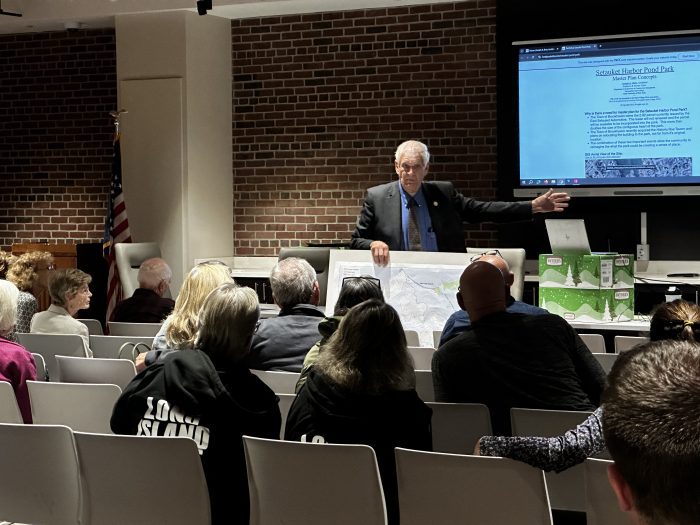By Lauren Feldman
St. John’s Episcopal Church of Huntington unveiled the new sign fronting its cemetery on Sunday, Sept. 8. The unveiling was accompanied by a lecture on the complex history of both St. John’s and the cemetery grounds, provided by local historians and preservationists.
Locals will note that the cemetery, located across from Huntington Hospital, is more than a stone’s throw from the church’s current location on the corner of Main Street and Prospect Street.
They may also find it odd that the church located next to these grounds is not, in fact, St. John’s, but the Bethel AME Church, which represents an entirely different congregation.

Historians Toby Kissam and Robert Hughes were on-site to explain the strange location of the cemetery grounds.
The church building today is the third one in the congregation’s history, erected at the beginning of the 20th century on land donated by Cornelia Prime. The first services were held in the new church on Pentecost, 1907. A new parish hall was built, and the church was consecrated in 1917.
The cemetery itself marks the grounds of the original church site. In the 1740s, the Rev. Samuel Seabury Sr. of St. George’s paid a visit to Huntington, where he found a small group of like-minded people. By the following year, enough settlers in the area were invested in forming their own parish.
A small church building was erected a little north of the Village Green, located along Park Avenue on the north side of Route 25A.
Throughout the Revolutionary War, Kissam said, there were no permanent ministers at the church, as Long Island was a region of divided loyalties. While there were many Tories loyal to the king, Huntington was a town of patriot sympathizers and no minister associated with the official church dared settle in the area.
Following the war, the church struggled to reorganize, and after five decades the original building was in a state of extreme disrepair.
By the 1860s, the vestry was debating whether to rebuild on the existing grounds or move elsewhere. The location of the church was perceived as inconvenient for most people to attend, consequently lowering attendance and enfeebling the church. But in spite of these disadvantages, the church was rebuilt on the original site.
Then in 1905 a fire destroyed the church’s building, and the church was rebuilt at its new (current) location, with the land provided by Prime.
And so it came to be that the church and its cemetery were separated across town. With the new sign in place, as well as inviting members of both the congregation and the village, the clergy of St. John’s hopes to continue to raise awareness for the ongoing efforts of the church to restore these sacred grounds.
Architectural conserver Joel Snodgrass walked visitors through the plans for preserving and restoring the grounds at St. John’s. The process will include bringing in professional landscapers to clear out the severe overgrowth of the grounds, as well as repairing and replacing some of the damaged ancient stones.
The unveiling of the cemetery sign comes at a pivotal time for the parish, which will be celebrating its 280th anniversary in 2025. Plans are underway to host and fundraise for a series of events in celebration of the longevity of the congregation. This information will soon be available on the parish’s website.

















 He’s heard numerous stories from a day in which the comfortable, clear air provided an incongruous backdrop for the mass murders. He has heard about people who were blown out of the buiding amid a combustible blast and about how difficult it is to put out a cesium fire.
He’s heard numerous stories from a day in which the comfortable, clear air provided an incongruous backdrop for the mass murders. He has heard about people who were blown out of the buiding amid a combustible blast and about how difficult it is to put out a cesium fire.
 Stony Brook Cancer Center’s CancerWise Café returns to SBU’s Charles B. Wang Center, 100 Nicolls Road, Stony Brook on Saturday, Sept. 28 from 8:30 a.m. to 4 p.m.
Stony Brook Cancer Center’s CancerWise Café returns to SBU’s Charles B. Wang Center, 100 Nicolls Road, Stony Brook on Saturday, Sept. 28 from 8:30 a.m. to 4 p.m.
 Set against the picturesque backdrop of The Shoppes at East Wind, this exciting festival will feature a variety of activities for all ages. Attendees can groove to the lively tunes of SouthBound, a popular local country band, and join in energetic line dancing sessions. For those with an appetite, a selection of mouth-watering food trucks will be on hand, offering a variety of delicious options to satisfy any craving.
Set against the picturesque backdrop of The Shoppes at East Wind, this exciting festival will feature a variety of activities for all ages. Attendees can groove to the lively tunes of SouthBound, a popular local country band, and join in energetic line dancing sessions. For those with an appetite, a selection of mouth-watering food trucks will be on hand, offering a variety of delicious options to satisfy any craving.


